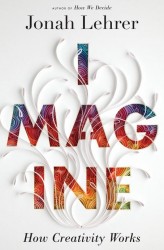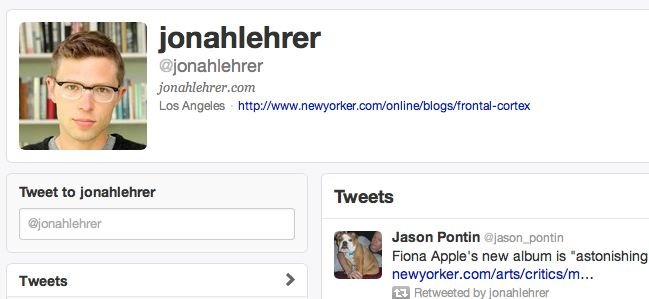The Fall of Jonah Lehrer
 Last month, Jonah Lehrer found himself at the center of a journalism controversy regarding self-plagiarism and when, if ever, it was ethical to reuse your old content.
Last month, Jonah Lehrer found himself at the center of a journalism controversy regarding self-plagiarism and when, if ever, it was ethical to reuse your old content.
At the time Lehrer was a rising star in science journalism. At just 31 years old, Lehrer had published three books, had written for many of the country’s most prestigious newspapers including The New York Times, the Wall Street Journal and the Boston Globe, and had just landed a new full-time job writing for The New Yorker.
However, the allegations shook Lehrer’s career in a major way. According to several reports, Lehrer had reused text in earlier books in articles for newer ones. This included text text written for other companies, raising potential copyright issues.
But while Lehrer survived the scandal, The New Yorker agreeing to keep him on so long as the error was not repeated, Lehrer had a bullseye placed on his back and others were already beginning to go through his work with a fine-tooth comb.
Inevitably they turned up something, something much worse.
Reporter Michael C. Moynihan turned up evidence that Lehrer, in his book “Imagine: How Creativity Works”, had fabricated several quotes from musician Bob Dylan. Lehrer himself now admits this and has resigned from The New Yorker and made a promise to help fix any inaccuracies in his work.
The case is being likened to the Jayson Blair scandal from nine years ago. So much so that Jayson Blair himself has been asked to weigh in on Lehrer’s case. There are many legitimate questions about what lies next for for Lehrer, as with other well-known plagiarists, but a lot more questions about what this means for journalism in general.
The issues of self-plagiarism and fabrication aren’t going away, but they may be getting much more common and much more difficult to deal with.
On Self Plagiarism and Fabrication
 Lehrer survived his first scandal almost completely unscathed. When it was discovered that he had reused words from his previous articles, the bulk of the online battle was drawn not to Lehrer himself, but to whether or not self plagiarism even exists.
Lehrer survived his first scandal almost completely unscathed. When it was discovered that he had reused words from his previous articles, the bulk of the online battle was drawn not to Lehrer himself, but to whether or not self plagiarism even exists.
For proof of that, look at the comments on my first article on Lehrer.
However, the scandal called into question Lehrer’s journalistic ethics and that, in turn, opened him up to scrutiny. Others began trying to find out what, if any, other misdeeds he had done and they found something. Though it wasn’t traditional plagiarism they found, fabrication is often considered to be one of the worst ethical violation a journalist (or researcher) can make. The reason is simple, journalists are supposed to be arbiters of the truth and fabrication is a form of lying in its most direct form.
In short, the self-plagiarism didn’t end Lehrer’s career, but it attracted the scrutiny that brought the larger issues to light.
However, it is very important to remember that this scandal is still very much unfolding and, like the Kaavya Viswanathan scandal before it, it’s likely that additional details will trickle out over time, even though Lehrer has said that all of the secrets are out.
So, unless Lehrer is telling the truth, things may still get a lot worse for Lehrer, the New Yorker and the other publications he worked for.
The Missed Opportunities and Warnings
But even as Lehrer’s world is crashing down around him, The New Yorker and the other publications Lehrer wrote for need to take a look at how they missed a very important warning sign and an important opportunity.
Whether or not you think that self plagiarism is an ethical violation, let alone one worth terminating a career over, it is definitely a warning sign. It’s a sign that a journalist might be struggling with their work, that they might be having difficulties or are unclear on certain areas of ethics in journalism.
When the first scandal broke, Lehrer was able to duck under the crossfire about whether or not self plagiarism is even an ethical issue and he escaped without much more than a warning from his editors. No reprimand, no formal investigation.
If The New Yorker, or his other publications, had launched any investigation they might have been able to find these (and any other) issues before they were leaked by other publications. Now it appears as if The New Yorker gave a fabricator a second chance despite good reason to be wary.
Yes, investigations take time and money, but this news would sound much better coming from The New Yorker than The Tablet and it isn’t as if there weren’t other cases to look deeper into. The Tablet article cites questions raised by philosopher Jonathon Keats claiming inaccuracies in a narrative Lehrer published in his first book. Other allegations came from a the New Republic review of “Imagine” by Isaac Chotiner review that claimed Lehrer was playing with some of the facts when discussing Dylan’s work.
Neither of these allegations alone prove anything but they are further warnings and, in the first case, came to light years before Lehrer began work at The New Yorker.
In short, The New Yorker almost gave an ethically-challenged journalist a free pass to write at one of the country’s most prestigious publications and, if it hadn’t been for other reporters doing what should have been their job, he might still be there today.
To Lehrer’s (Former) Defenders
During the self-plagiarism scandal/controversy, Lehrer had more than his share of defenders and many of them attacked me for both my stance on self-plagiarism and for saying that, at the very least, there should be an investigation into Lehrer’s work.
Though many simply wanted to let Lehrer go, the truth is that an investigation was warranted. Though I recognized that an investigation based on the allegations at hand may not have been practical without some kind of legal risk to provoke it, I, and others, called for it and it seems we were right to do so.
Obviously, Lehrer’s defenders have backed away now and I doubt that the comments/feedback to this post will be as divisive. But the issue of self plagiarism is going to come up again. This includes in journalism, academia and elsewhere.
Hopefully this case will show that, even if you don’t think self-plagiarism by itself is an issue or even something that exists, this case does highlight it as a warning sign. This isn’t a slippery-slope argument nor even a correlation one, but an acknowledgement that people who are trying to do good, ethical work in their field will usually work to avoid unacknowledged reuse of their old work.
Those who engage in self-plagiarism, at the very least are getting dangerously close to larger ethical issue and it’s worth examining to make sure that things haven’t gone farther and that they don’t in the future.
Ignoring it outright is simply inviting greater disaster.
Bottom Line
In the end, the real lesson of the Lehrer case is this: If you are a prominent figure and you are accused of self plagiarism, or any other ethical violation, even if you escape the initial scandal, there WILL be an investigation.
The question is where will that investigation come from. Will it be your employers or the media? Will it be your boss or a reporter miles away from you? Will it be a friend or a stranger?
The tools for looking into ethics violations are much more widespread, easier to use and less expensive. If there is enough interest in tracking your errors and misdeeds, someone will do it.
So while you may be able to build a career on plagiarism and dishonesty, you probably can’t build a grand one, at least not long term.
If you do, it’s not long before the attacks against you begin to stick and, once that happens, it’s not long before your defenses crumble, not due to any single revelation, but a barrage of people wanting to find the next piece of the puzzle.
Want to Reuse or Republish this Content?
If you want to feature this article in your site, classroom or elsewhere, just let us know! We usually grant permission within 24 hours.
